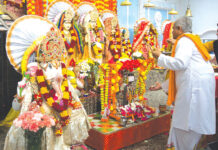News East West
Every student of Indian history and culture knows the ancient city of Hastinapur mentioned in the Mahabharata. While the above picture shows the Lotus Temple in Hastinapur, not far from New Delhi, the story and pictures below tell the story of another
Hastinapur in Buenos Aires (Argentina) of all places. Read on…
Hastinapur (in Argentina capital Buenos Aires) has a total area of twelve acres. Its population consists of a dozen Indian gods and an equal number of Argentinians. Some of the Indian gods reside in authentic temples filled with the scent of Indian agarbatties while others stay outdoors enjoying the fragrance of the flowers from the garden. Some are sitting or standing on the pedestals and others hang on the sides of walls and pillars.
The gods who have their own temples include Ganesh, Krishna, Surya, Narayana and Shiva. Since it is Hastinapur there is a temple for Pandavas too. Hastinapur is clearly a place fit for the gods …who should be pleased with the cleanliness of the place, the serene surroundings and the green garden with Rosewood trees. The only noise comes from the hundreds of birds nesting in the trees. Then there is the soft music of the devotees who sing Bhajans. It is indeed a divine place which inspires sacred thoughts and holy spirit.

A dozen Argentinians live there to look after the gods and the place. During weekend, the human population increases to over one hundred. The Argentinians do not go there seeking favours as many Indians do in Tirupathi. They go there for wisdom. This is why Hastinapur is called as the City of Wisdom (ciudad de la sabiduria). Saraswati, the Goddess of Learning, blesses the students through the sculptures all around the compound. The Argentines learn philosophy, read in the library, practise yoga and meditation and sing Bhajans.
On the other side of the fence, there are cows grazing and occasionally staring at the Indian gods. The cows are relaxed and free from fear because they know that they will not become food at the dining table in Hastinapur, which is a vegetarian place. The inmates cook vegetarian food and share it with the children from poor families in the neighbourhood.
Hastinapur does not have any godmen seeking fame and fortune and flaunting wealthy followers. It is an institution to pursue pure wisdom, peace and divinity. Neither in the city nor in the website names of those who run the place are given. The founders and directors of the Hastinapura Foundation do not seek publicity. They are humble but devoted people. They have their professions as company managers, engineers or professors. They volunteer their time and talents for the foundation.
Nor is Hastinapur the work of some overenthusiastic drum-beating Hare Krishna types or faith-lead Saibaba followers. Hastinapur respects all the religions and beliefs. Their ten temples include one for Buddha, one for the Virgin Mary, one for the Greek god Demeter and another one called as the the Temple of All Faiths.
Their library has books of all religions and schools of thought. Hastinapur seeks true wisdom, going beyond the boundaries of established religions. The City of Wisdom is not the ultimate destination. It does not prescribe wisdom doses. It simply helps people to seek, find and pursue their own path to wisdom. They give classes in yoga, meditation, philosophy, devotional singing and sacred drama. They organise workshops, seminars and retreats. They also provide community service. They celebrate festivals such as Ganesh Chathurthi and Vaishaki. Their next project is to broadcast through radio.
Hastinapur temples do not have priests or other middlemen between the gods and worshippers. There is no money collection, like in Tirupathi. Worshippers pray, recite mantras and sing devotional songs individually or in groups.

Hastinapur has a post-graduate course in yoga which takes three years to complete. The classes are held in the weekends only. There are 2,500 students studying yoga and philosophy in the Hastinapur centres. The students are being taught by 100 teachers on philosophy and 120 teachers on yoga.
Many Argentinians go to Hastinapur as a retreat from the hectic city of Buenos Aires which is just fifty kilometres away. They practise meditation in the quiet natural environment. They do yoga, read books from the library, discuss philosophy and join the singing of bhajans. Hastinapur is an authentic Ashram.
The Hastinapur Foundation has published a number of books on Indian philosophy and translated the Bhagwat Gita, Bhakti Sutras, Upanishads, Srimad Bhagwatam and Yoga Sutras. Their latest publication is the Mahabharata in Spanish. They have so far published three volumes and plan to do a total of twelve volumes in the coming years. Each volume is over 500 pages. The founder Alda Albrecht and other members of the Foundation have also written a number of books.

The Hastinapura Foundation was established by Ada Albrecht in 1981. She introduced Indian philosophy and became a Guru for the Argentinians seeking wisdom. She wrote a number of books such as ¨The Saints and teachings of India¨ and ¨The teachings of the monks from Himalayas¨.
Gustavo Canzobre was one of her students, who is now the Director of the Hastinapur college of professors. He was seventeen years old when he became interested in Indian wisdom. During the Third Festival of India organized by the Indian embassy in Buenos Aires in November 2010, he gave a talk on the temple architecture of South India. He is a manager in a local company for living and dedicates rest of his time to the Hastinapura Foundation. He is knowledgeable about the Vedas and the Upanishads.

The architectural and scuplting work of the Hastinapur complex has been done entirely by Argentinians. The architects and sculptors have studied Indian temples and have done their work professionally and aesthetically. Even now they are constructing some more buildings with Indian sculptures and statues.



The Hastinapura Foundation has sixteen centres in Buenos Aires and three more in the rest of Argentina. They have also established centres in Uruguay, Bolivia and Colombia.

Latin Americans are, of course, known for fun and fiesta. At the same time, there are thousands of Latin Americans who take the Mahabharata and meditation more seriously than many Indians….
(This article appeared here first)
Comments









I was in Buenos Aris on Sept. 13-16 2016. My family wanted to see the well known Hastinapure near BuenoAris .I had read from Times of India .we belong to the original Hastinapur (Delhi) and my wife belonged to Kurukshetra India ,site for Mahabharata war and Krishna Geeta.
I was disgusted to learn that in spite of several attempts by me and the travel agent we were not allowed to visit the place.
How do the Organisers at Hastinapur expect to propagate and inform the people from India regarding this place on the opposite side of iIndia.
I still could not get the reason for not allowing us who are strong Hindus to visit this place. .
Hopefully the governing bodies of Hastinapur Near BuenoAris get their acts together and aloof visitors to visit this place!!
Sincerely,
Dr. Satish K .Lal
How does it have much more than the Hastinapur of Mahabharat? Care to elaborate?